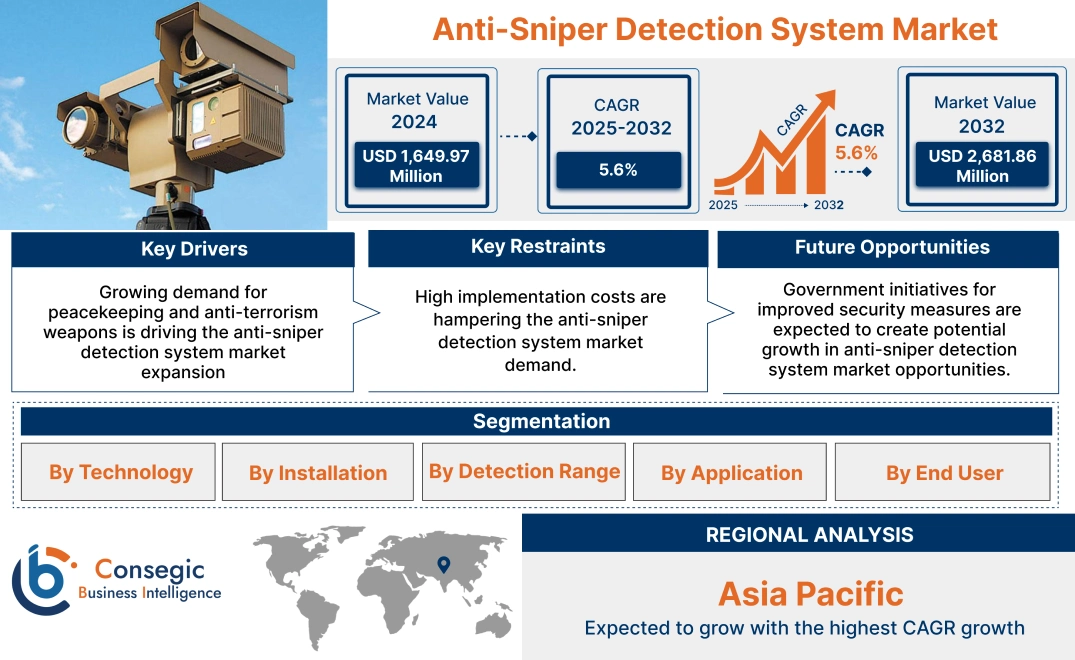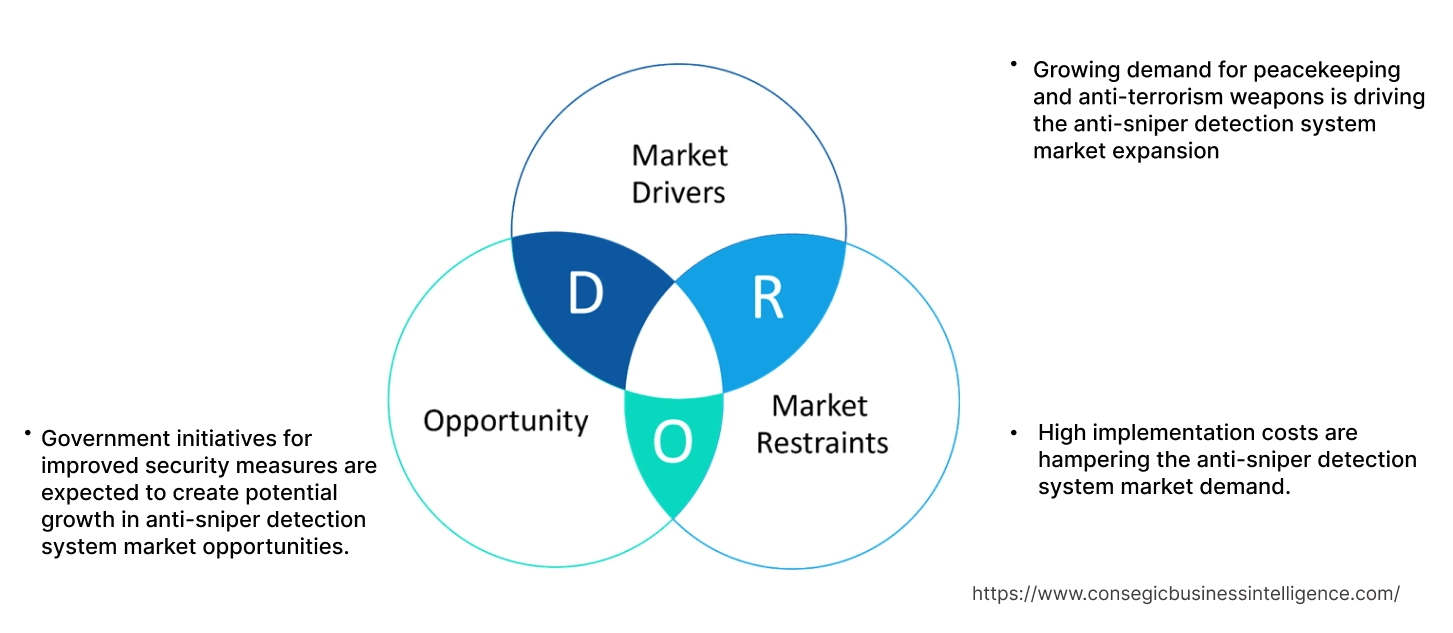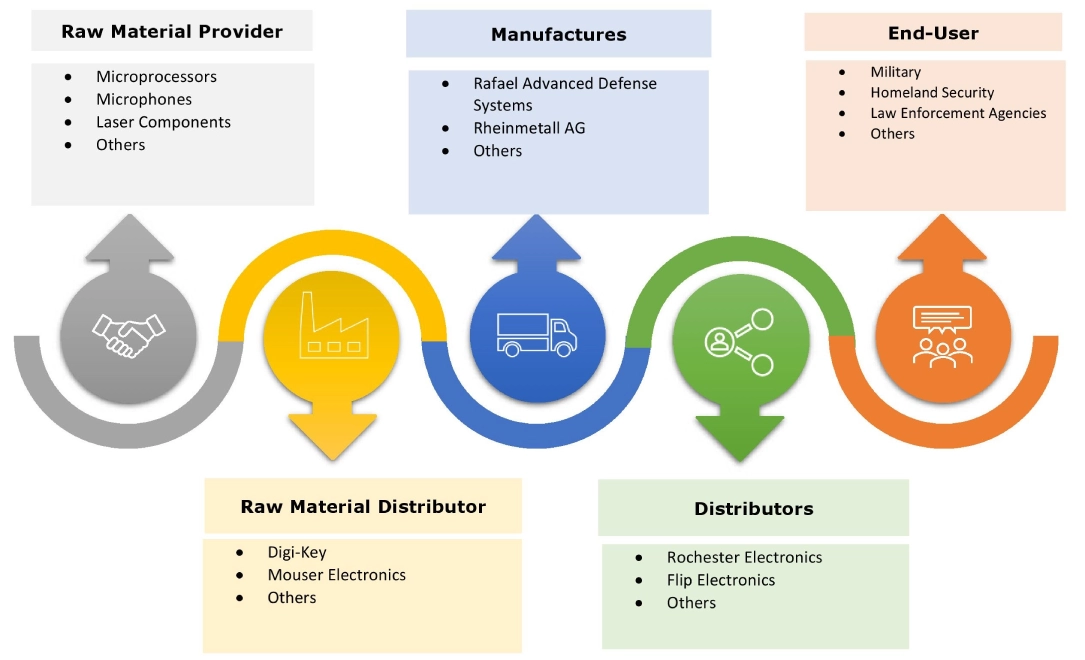- Summary
- Table Of Content
- Methodology
Anti-Sniper Detection System Market Size:
Anti-Sniper Detection System Market Size is estimated to reach over USD 2,681.86 Million by 2032 from a value of USD 1,649.97 Million in 2024 and is projected to grow by USD 1,740.55 Million in 2025, growing at a CAGR of 5.6% from 2025 to 2032.
Anti-Sniper Detection System Market Scope & Overview:
An anti-sniper detection system is a versatile and modular setup that utilizes various technologies to identify targets. These systems assist in determining the location, distance, and coordinates of a sniper. With the assistance of these systems, soldiers are able to identify anti-snipers shooting from remote locations, rapidly aim at enemy snipers, and promptly return fire.
Key Drivers:
Growing demand for peacekeeping and anti-terrorism weapons is driving the anti-sniper detection system market expansion
The anti-sniper detection systems are intended to identify and pinpoint snipers before they can target individuals. These systems generally employ a mix of sensors, including acoustic sensors, laser rangefinders, and thermal imagers, to recognize the muzzle flash, noise, and heat signature of a sniper rifle. In addition to this, laser detection systems are becoming popular in these types of detection systems. Manufacturers are intensifying research on detectors that utilize the cat eye effect to identify snipers by locating their aiming telescopes. They are enhancing the availability of systems capable of determining a sniper's position prior to the individual taking a shot.
- For instance, in September 2021, MF Stelmak showcased its Sosna-N robotic sniper detector at the Army 2021 International Military Technical Forum. This laser-optical system is capable of automatic and remote-controlled operations and is designed to scan for an optical devices, such as binoculars, anti-tank missiles, and sniper rifle scopes.
Thus, according to the anti-sniper detection system market analysis, the increased demand for anti-terrorism weapons is driving the anti-sniper detection system market size.
Key Restraints:
High implementation costs are hampering the anti-sniper detection system market demand.
The creation and implementation of sophisticated technology for identifying sniper threats can be costly, which makes these systems harder to obtain for smaller organizations, especially in the civilian realm. Financial factors include the purchase of detection devices, along with costs related to installation, upkeep, and staff training.
Furthermore, continuous operational expenses can strain users, impacting the acceptance of these systems. Consequently, the market encounters difficulties in expanding its customer reach, despite the urgent demand for sniper threat detection in an increasingly security-conscious environment. These factors are hindering the growth of the anti-sniper detection system market.
Future Opportunities :
Government initiatives for improved security measures are expected to create potential growth in anti-sniper detection system market opportunities.
Governments worldwide are emphasizing the improvement of security measures to safeguard critical assets, public areas, and military sites from sniper threats. These efforts involve funding research and development, acquiring advanced detection systems, and encouraging partnerships with private-sector companies. Government-imposed regulations and standards further drive innovation and acceptance in the market. The trust and financial backing provided by governments not only strengthen the anti-sniper detection system market demand but also foster a favorable atmosphere for collaboration and technological progress. As governments maintain a focus on security amidst a constantly changing threat landscape, these initiatives present a substantial growth prospect for manufacturers and providers, with an enlarging and supportive customer base in the security and defense industries.
- For instance, in December 2022, Shooter Detection System announced the collaboration with the Department of Homeland Security (DHS) Science and Technology Directorate, to launch a portable gunshot detection system. This system offers immediate information on outdoor shooting events. Additionally, this mobile system, an improvement of the current guardian indoor shooter detection system, employs both auditory and visual signals to confirm each gunshot, greatly minimizing false alarms.
Thus, rising government initiatives for improved security measures are driving the anti-sniper detection system market opportunities.
Anti-Sniper Detection System Market Segmental Analysis :
By Technology:
Based on the technology, the market is segmented into acoustic and optronics.
Trends in the technology:
- The rising frequency of terrorist attacks and conflicts has fuelled the demand for effective anti-sniper systems.
- Governments and organizations are aggressively investing in protecting VIPs and dignitaries from sniper attacks. The above trends would further drive the anti-sniper detection system market during the forecast period.
The acoustic segment accounted for the largest revenue in the year 2024.
- These detection systems are frequently utilized by law enforcement agencies and military personnel during patrols, at checkpoints, and while securing temporary installations. Their capability to deliver prompt alerts and directional information regarding the source of gunfire makes them crucial in swiftly evaluating and addressing threats, thus minimizing potential casualties.
- Technological advancements play a vital role in the segment’s growth. Innovations in acoustic sensor tech technology, signal processing algorithms, and real-time data analysis have significantly enhanced the performance of acoustic anti-sniper systems. These advancements make it possible to detect and locate sniper fire with greater precision and reliability, further fuelling the adoption of these systems in several security applications.
The optronics segment is anticipated to register the fastest CAGR during the forecast period.
- Laser detection systems are growing more sensitive, enabling them to identify laser beams from greater distances and in more difficult environmental conditions. This enhanced sensitivity is vital for prompt warnings and quick responses to potential threats.
- Laser detection systems are increasingly integrated with various security technologies, including surveillance cameras, access control systems, and command-and-control centers. This integration facilitates a more thorough and coordinated security response.
- For instance, Defense Advanced Research Program Agency (DARPA) has developed a battlefield optical surveillance system, that utilizes a forward-looking infrared thermal camera to detect potential targets. The system offers the capability to detect snipers before a shot is fired by relying on the detection of optical augmentation and thermal characteristics of a sniper.
- Thus, based on the analysis and trends, the advancements in technology of laser systems are driving the anti-sniper detection system market size and growth.
By Installation:
Based on the installation, the market is segmented into fixed, portable, and vehicle-mounted.
Trends in Installation:
- The growing need for rapid deployment and flexibility is driving the market during the forecast period.
- Unmanned Aerial Vehicles (UAV) can be equipped with sensors and cameras to provide aerial surveillance and enhanced capabilities of ground-based systems. The above factors would further drive the anti-sniper detection system market during the forecast period.
The fixed segment accounted for the largest revenue in the year 2024.
- Modern fixed installations frequently integrate a mix of acoustic, optical, radar, and seismic sensors. This combination of sensors improves detection precision and minimizes false alarms.
- Artificial intelligence algorithms are used to assess data from various sensors to more effectively detect potential threats, even in intricate surroundings.
- As fixed installations grow more interconnected, cybersecurity becomes an essential issue. Manufacturers are putting in place strong security measures to safeguard systems against cyber threats.
- Therefore, based on the above market analysis, the fixed installation type will dominate the market share.
The portable segment is anticipated to register the fastest CAGR during the forecast period.
- Portable anti-sniper detection systems provide versatility and quick action, making them essential for military, law enforcement, and security staff who must address sniper threats in evolving situations.
- Their small and lightweight construction facilitates rapid deployment, guaranteeing that vital locations are promptly safeguarded against sniper assaults. This feature is particularly important in situations such as tactical missions, border protection, or event security where mobility and flexibility are critical.
- Portable sniper detection systems enhance security and situational awareness across various dynamic and fluctuating security environments.
- For instance, in June 2021, Shooter Detection Systems announced its partnership with Singlewire Software to improve active shooter safety. The integration will allow organizations utilizing both systems to automatically send emergency notifications to those in danger through various methods at the same time, such as audio broadcast systems, digital signage, desktop alerts, mobile devices, and email in response to gunfire within a building.
- Thus, the above analysis along with recent developments associated with portable anti-sniper detection systems are fostering innovation and broadening the market prospect.
By Detection Range:
Based on the detection range, the market is segmented into up to 500m, 500 m-1000 m, and 1000 m-2000 m.
Trends in the Detection Range:
- There is a growing need for systems with longer detection ranges to provide earlier warnings and increased protection.
- Ongoing research and development are focused on developing new sensor technologies that offer improved sensitivity and longer detection ranges. Thus, the above analysis and factors further supplement the anti-sniper detection system market trends during the forecast period.
500m-1000m accounted for the largest revenue share of 56.21% in the year 2024 and is expected to register the highest CAGR during the forecast period
- The development of highly sensitive laser detection systems allows for the detection of laser beams emitted from sniper scopes at extended ranges.
- They offer a wider observation zone compared to short-range systems while still ensuring greater precision and faster detection times than long-range systems, which may experience lags because of the lengthy data processing needed over greater distances.
- Medium-range systems are especially beneficial in situations like securing military installations, temporary camps in war zones, or large public events where the risk of a sniper threat could arise from a moderate range.
- The protection of critical infrastructure, such as power plants, airports, and government buildings is driving the demand for a longer range of detection systems.
- These factors further supplement the anti-sniper detection system market trend during the forecast period.
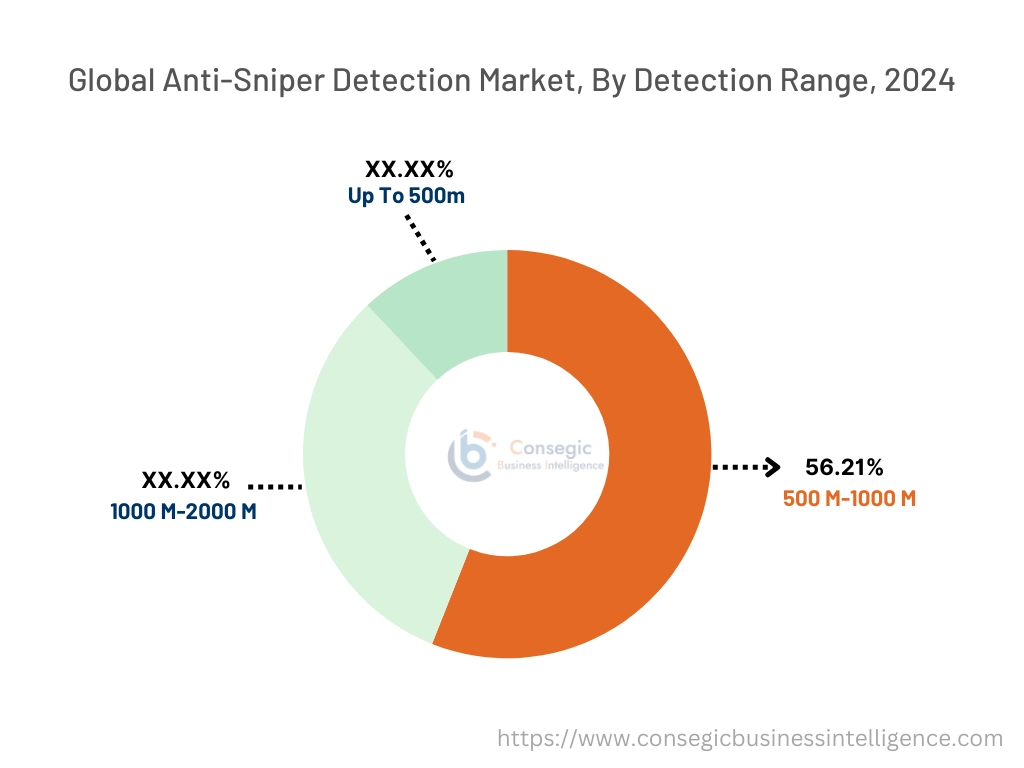
By Application:
Based on end-user, the market is segmented into perimeter intrusion detection, border protection and control, camp protection, critical infrastructure detection, VIP protection, convoy protection, target acquisition, building entrances, hospital emergency entrances, sports venues, and others.
Trends in the Application:
- The growing emphasis on VIP protection and the safety of government officials has contributed to the market’s growth.
- High-profile events, such as international summits, political rallies, and public gatherings, require robust security measures to mitigate the risk of sniper attacks. These factors and trends would further drive the market during the forecast period.
Critical Infrastructure accounted for the largest revenue share in the year 2024.
- Critical infrastructure represents high-value assets, which are particularly vulnerable to targeted attacks, making the need for robust anti-sniper detection systems.
- Integrating data from various sensors, including acoustic, seismic, and visual sensors, enhances detection capabilities significantly. This data fusion facilitates the triangulation of a sniper's location and reduces the occurrence of false alarms.
- The escalating risk of cyberattacks on critical infrastructure underscores the necessity for comprehensive security solutions that encompass both physical and cyber defense.
- These systems deployed in critical infrastructure often integrate multiple technologies, such as advanced analytics, radar systems, and infrared cameras to accurately identify and locate potential threats.
The VIP protection segment is anticipated to register the fastest CAGR during the forecast period.
- VIP protection is a significant application for anti-sniper detection systems. Infrared detection systems offer an essential protection measure, allowing security agencies to swiftly and effectively identify and respond to sniper threats.
- Modern systems utilize advanced sensors, high-resolution cameras, and complex software algorithms that improve their detection abilities.
- These systems can accurately identify sniper threats, even in difficult environmental conditions. This effectiveness makes them valuable in numerous security situations, including safeguarding in public areas.
- The aforementioned factors would further drive the market during the forecast period.
By End User:
Based on end users, the market is segmented into military, homeland security, law enforcement agencies, and others.
Trends in the End User:
- The growing need for security solutions in emerging economies is driving the market for these systems.
- The development of smaller and more portable systems is making them more accessible for a wider range of applications.
The military segment accounted for the largest revenue in the year 2024.
- The military & defense industry occupies a substantial portion of the market since these systems are essential for reconnaissance missions, perimeter defense, and active combat scenarios to identify and counter threats from snipers. The capability of infrared systems to function in different environmental conditions, such as night-time and poor weather, offers a considerable tactical edge.
- These systems enable military units to observe potentially dangerous areas without putting personnel at direct risk, thus, lowering casualties and enhancing mission success rates.
- Further, the incorporation of these systems with other military technologies, such as unmanned aerial vehicles (UAVs) and sophisticated command and control systems, further improves their efficiency.
- For instance, in December 2023, the Indian Army tested a smart scope powered by AI that can detect humans up to 300 m, which can boost border and close combat operations. Utilizing an AI algorithm and sensory information, it can notify the shooter when to take a shot. It demonstrated an accuracy rate of 80-90% during tests conducted at distances of 100-300 meters.
- According to the analysis, the above factors are expected to drive the anti-sniper detection system market during the forecast period.
The law enforcement agencies segment is anticipated to register the fastest CAGR during the forecast period.
- These systems are used to improve safety in public gatherings, such as marathons, political rallies, or parades where the likelihood of sniper attacks may be increased. By establishing these systems around event boundaries or in key areas, law enforcement can observe for possible dangers from afar, safeguarding the well-being of participants and spectators without interfering with the event.
- The implementation of these systems in city settings also supports regular patrols and monitoring efforts, especially in regions susceptible to violent crime or gang operations. The capacity to swiftly detect and respond to gunfire can greatly lower the danger to both officers and the public.
- The use of these technologies illustrates a wider movement in law enforcement toward utilizing military-grade gear to improve response functions and safeguard public safety in a progressively intricate security environment.
- The aforementioned factors are projected to boost the market during the forecast period.
Regional Analysis:
The global market has been classified by region into North America, Europe, Asia-Pacific, MEA, and Latin America.
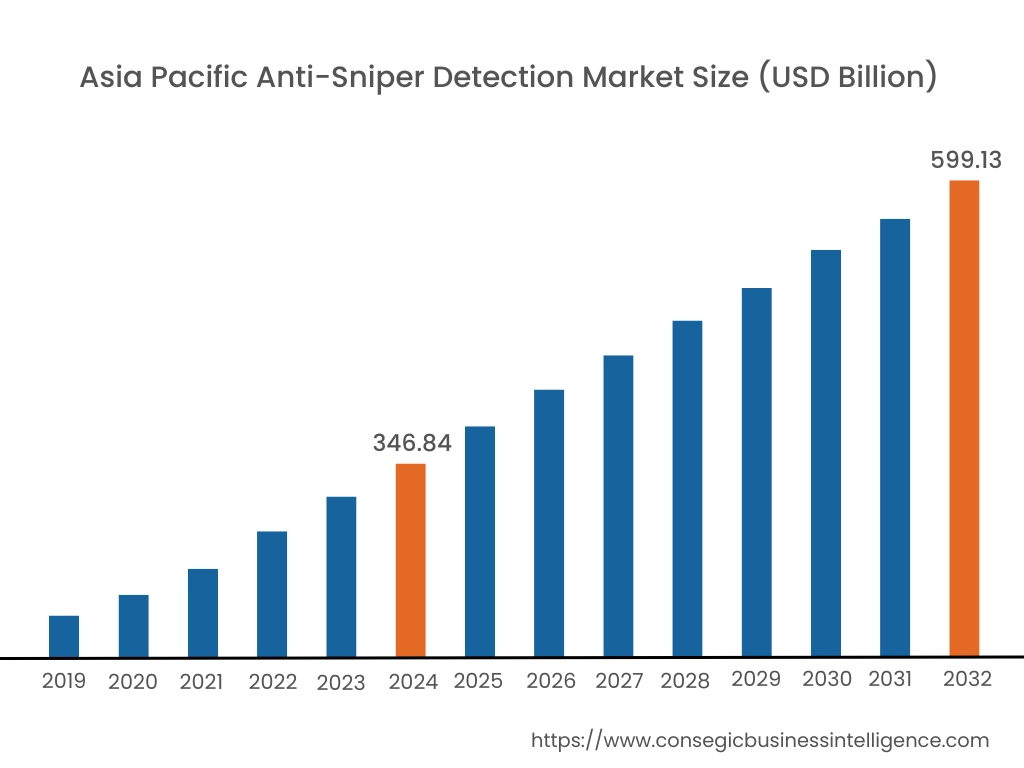
Asia Pacific's anti-sniper detection system market is estimated to reach over USD 599.13 Million by 2032 from a value of USD 346.84 Million in 2024 and is projected to grow by USD 367.79 Million in 2025. Out of this, China's anti-sniper detection system industry accounted for the maximum revenue share of 32.43%. The regional anti-sniper detection system market growth is mainly driven by heightened security concerns and growing military modernization initiatives in the area. With a variety of geopolitical issues, the need for sophisticated detection systems is increasing. Countries in the Asia Pacific are making substantial investments in defense technologies, encompassing anti-sniper solutions to protect vital infrastructure, military sites, and public areas. Furthermore, the regional anti-sniper detection system market share gains from an expanding urban environment, accommodating high-profile events and infrastructure projects that necessitate improved security measures.
- For instance, in September 2023, India’s Defense Research & Development Organisation (DRDO) developed a long-range optical target locator 1500. The system is capable of effectively potential threats and allows thorough inspection of VIP areas.
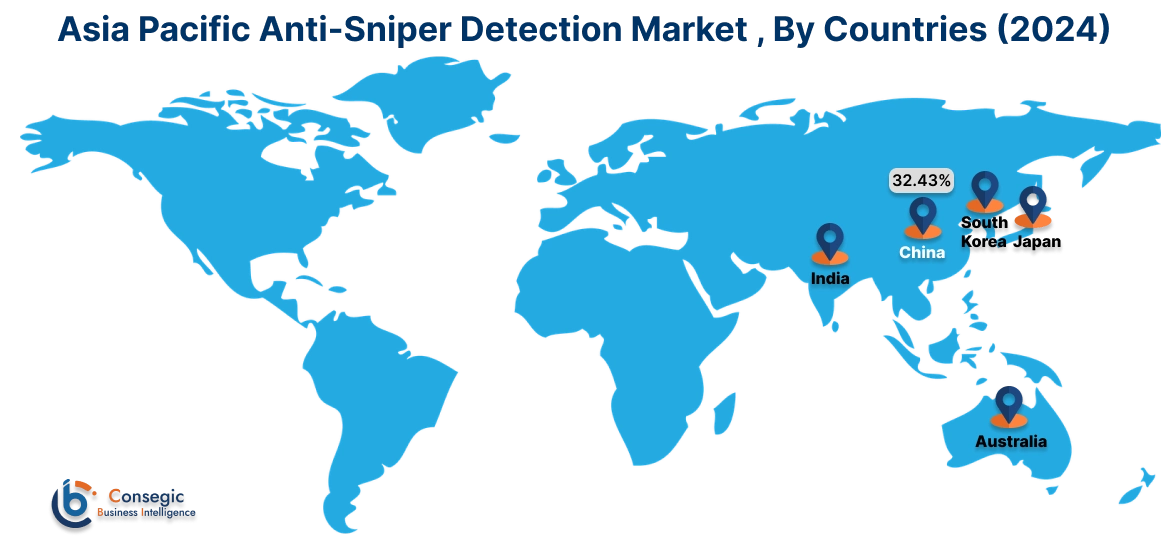
North America's anti-sniper detection system market growth is estimated to reach over USD 989.34 Million by 2032 from a value of USD 614.77 Million in 2024 and is projected to grow by USD 647.99 Million in 2025. The North American region is home to several leading firms in the defense technology field that are consistently enhancing anti-sniper technologies. These advancements involve the incorporation of artificial intelligence, machine learning algorithms, and improved sensor functionalities, which greatly enhance the precision and reaction times of detection systems. In addition to this, the US military's focus on force protection and the rising adoption of these systems in law enforcement agencies nationwide further drives the market. Moreover, the region's strong technological framework facilitates swift testing and implementation of new technologies, supporting market expansion in the area. These factors would further supplement the regional anti-sniper detection system market share during the forecast period.
- For instance, in June 2022, Artificial Intelligence Technology Solutions, Inc. announced that its wholly owned subsidiary Robotic Assistance Devices (RAD) has formed a partnership with EAGL Technology, Inc. to provide EAGL’s Anti-Sniper Detection System (GDS) in all existing and anticipated future RAD devices.
As per the anti-sniper detection system market analysis, Europe has encountered many security issues in recent years, such as terrorist attacks and the emergence of extremist factions. This has resulted in a greater need for efficient security solutions, including anti-sniper technologies. Additionally, several countries in Latin America are allocating resources to upgrade their security forces, which includes obtaining state-of-the-art surveillance and detection technologies. Furthermore, in the Middle East and Africa (MEA), the defense industry has suffered from conflicts and terrorist actions, resulting in an increased requirement for security measures to safeguard essential infrastructure, military staff, and the public.
Top Key Players and Market Share Insights:
The global anti-sniper detection system market is highly competitive with major players providing casino management solutions to the national and international markets. Key players are adopting several strategies in research and development (R&D), product innovation, and end-user launches to hold a strong position in the market. Key players in the anti-sniper detection system industry include-
- Newcon Optik (Canada)
- WTDS Optics (China)
- MH TECH (China)
- Databuoy Corporation (U.S.)
- Shooter Detection Systems LLC (U.S.)
- ZeroEyes (U.S.)
- QinetiQ (U.K.)
- Thales Group (France)
- Rafael Advanced Defense Systems (France)
- Transvaro elektron aletleri (Turkey)
- Rheinmetall AG (Germany)
Recent Industry Developments :
Expansion:
- In October 2024, ZeroEyes announced that it has become a member of the Authorized Integrators Network (AiN Group), a network of AV and security dealers. AiN Group's members can provide active gun detection and smart situational awareness platforms to commercial clients of ZeroEyes.
Anti-Sniper Detection System Market Report Insights :
| Report Attributes | Report Details |
| Study Timeline | 2019-2032 |
| Market Size in 2032 | USD 2,681.86 Million |
| CAGR (2025-2032) | 5.6% |
| By Technology |
|
| By Installation |
|
| By Detection Range |
|
| By Application |
|
| By End User |
|
| By Region |
|
| Key Players |
|
| North America | U.S. Canada Mexico |
| Europe | U.K. Germany France Spain Italy Russia Benelux Rest of Europe |
| APAC | China South Korea Japan India Australia ASEAN Rest of Asia-Pacific |
| Middle East and Africa | GCC Turkey South Africa Rest of MEA |
| LATAM | Brazil Argentina Chile Rest of LATAM |
| Report Coverage |
|
Key Questions Answered in the Report
How big is the Anti-Sniper Detection System market? +
Anti-Sniper Detection System Market Size is estimated to reach over USD 2,681.86 Million by 2032 from a value of USD 1,649.97 Million in 2024 and is projected to grow by USD 1,740.55 Million in 2025, growing at a CAGR of 5.6% from 2025 to 2032.
Which is the fastest-growing region in the Anti-Sniper Detection System market? +
Asia-Pacific is the region experiencing the most rapid growth in the market.
What specific segmentation details are covered in the Anti-Sniper Detection System report? +
The anti-sniper detection system report includes specific segmentation details for technology, installation, detection range, application, end user, and region.
Who are the major players in the Anti-Sniper Detection System market? +
The key participants in the market are Newcon Optik (Canada), WTDS Optics (China), Thales Group (France), QinetiQ (U.K.), Rafael Advanced Defense Systems (France), Transvaro elektron aletleri (Turkey), Rheinmetall AG (Germany), MH TECH (China), Databuoy Corporation (U.S.), Shooter Detection Systems LLC (U.S.), ZeroEyes (U.S.), and others.
